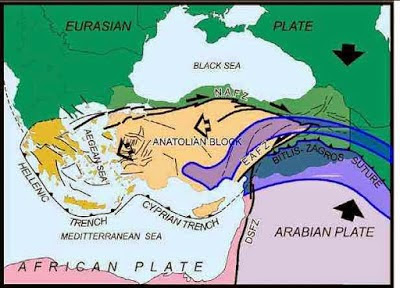The United States Geological Survey recorded a Magnitude 5.7 Earthquake at a depth of 70.6 km,to the south of the island of Crete, slightly before 7.10 am local time (slightly before 5.10 am GMT) on Wednesday 29 December 2021. No damage or injuries have been reported following this event, but people have reported feeling the quake as far away as Sicily, southern Anatolia, and the Egyptian cities of Alexandria and Cairo.
The approximate location of the 29 December 2021 Crete Earthquake. USGS.
The island of Crete lies to the north of the boundary between the Aegean Sea Plate, which
underlies southern Greece, and the African Plate, which underlies most
of the Mediterranean. The African Plate is moving northward relative to
the Aegean Sea Plate, and is being subducted beneath it along the
Hellenic Trench, which runs from the Ionian Sea to the south and west of
the Peloponnese and then to the south of Crete. This is not a smooth process, as the plates frequently stick together
then break apart once the pressure has built up sufficiently, leading to
(fairly frequent) Earthquakes.
To the east the Arabian Plate is being pushed north and west by the movement
of the African Plate, further to the south. This leads to a zone of
tectonic activity within the province, as the Arabian and Anatolian plates are pushed
together, along the East Anatolian Fault, and past one-another, along
the Dead Sea Transform.
This movement also leads to a zone of faulting along the northern part
of Turkey, the North Anatolian Fault Zone, as the Anatolian Plate is
pushed past the Eurasian Plate, which underlies the Black Sea and
Crimean Peninsula (transform faulting). This is not a simple process,
as the two plates constantly stick together, then break apart as the
pressure builds up, leading to Earthquakes, which can be some distance
from the actual fault zone.
Simplified map of the plate movements of the eastern Mediterranean. Univeriteit Utrecht.
See also...








